Huguette CHEMLA, 1931 – 1944
INTRODUCTION
First of all, we would like to thank Mr. Richard Avizrat, who lives in Israel, for his valuable help and for the time he devoted to us as we tried to piece together the biographies of his family members (his grandmother, Zakia, and his uncles and aunts, Robert, Huguette, Gilbert and Georgette) who all perished in Auschwitz on August 5, 1944.
Next, we decided to continue this introduction with his interview and our feelings about this very moving conversation.
We felt, following Mr Avizrat’s call, when we learned that his mother had passed away, that he rarely talked about his family and had never asked. Mr. Avizrat had learned about what had happened in school.
Since he lives in Israel, he started his research, at the age of 50, at Yad Vashem (the Israeli Holocaust memorial). He traveled twice to Paris to see a cousin and once to Lyon to do further research. He searched for documents and found some photos at his parents’ home.
The staff at Lyon City Hall and Lyon Police helped him with his research. He thinks of the lives of his deported family as a jigsaw puzzle, and as each day passes there are fewer pieces left to find.
Since 2006 he has never stopped looking for more information about his family, and has read numerous books to help broaden his research.
Finally, taking into account the Covid restrictions, and with the help of the archived documents sent by Mr Serge Jacubert and Ms. Claire Podetti of the Convoy 77 association, whom we would also like to thank, we have done our best to pay tribute to this unfortunate family from Lyon, who had previously lived in Algeria. They left behind just one descendant: Louise Aouizrat, née Chemla, who has continued her research in order to have the status of her parents and siblings recognized. Her father, Moïse, was machine-gunned to death, and the others were deported. It is in part thanks to her tenacity that we now have a lasting tribute to the Chemla family.
A HISTORICAL JIGSAW PUZZLE
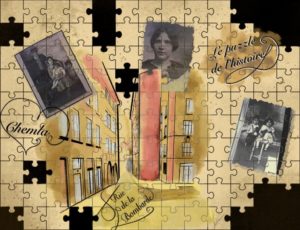
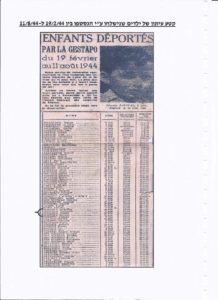
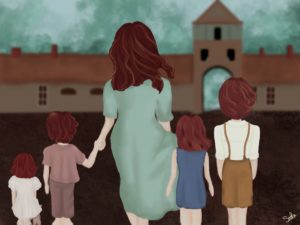
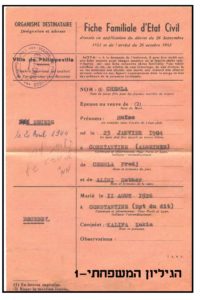
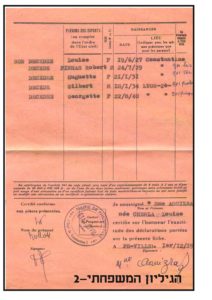
THE BIOGRAPHY
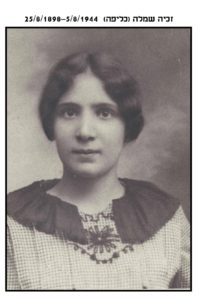

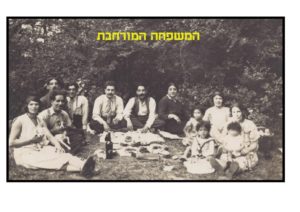
Born on August 25, 1898 in Constantine, Algeria, at a time when Algeria was a French colony, Zakia lived her husband, Moïse, and her first three children; Louise, Robert and Huguette.
She did not work outside the home since her husband provided for the family’s needs by working as a laborer at Descours-Cabaud, a building materials factory that opened in Lyon in 1782.
She moved to France with her husband and two youngest children to join some of her family, but we do not know exactly when. However, given that Gilbert and Huguette were born in 1931, we suppose that they arrived in Lyon after that.
We only know that Louise had to stay in Algeria for medical reasons, probably because the climate was more suitable for her.
According to the documents in our possession, in particular the photographs, we believe that Zakia was a confident, composed woman who came from a large family and appreciated nature.
After the death of her husband, Moïse, who was shot on April 20, 1944 for his anti-German activities, she and her children were rounded up in a friend’s apartment on July 8, 1944. This was the beginning of a terrible ordeal for the family, due simply to their Jewish faith
The fact that they were transferred to Drancy, a transit camp in the Paris area, on July 24, 1944, reveals the meticulous way in which the French police identified and searched for people.
The only valuable object confiscated from her on arrival in Drancy was an earring. The rest we know: On July 31, 1944, she boarded the Convoy 77 train, together with her children and the other deportees, heading for the death camp at Auschwitz-Birkenau in Poland, where she died on August 5, 1944.
At the end of the war, most of the those who had escaped the camps (having been in hiding, rescued or living elsewhere) began to search, often having to cross complicated administrative hurdles, for deportees who had survived.
This was what Zakia’s sister, Yasmina Mabitz, did first, and then her daughter Louise Aouizrat, took the necessary steps to have her mother and her brothers and sister acknowledged as political deportees and being granted the status “Died for France”.
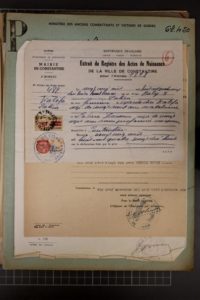

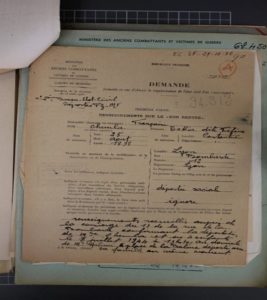
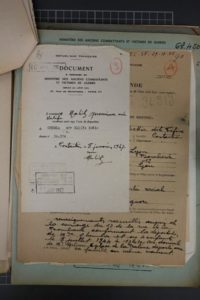
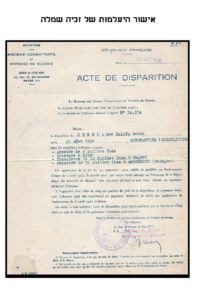

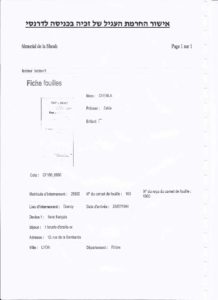
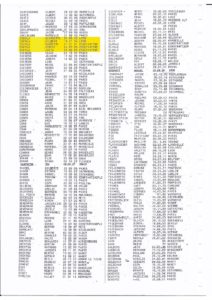
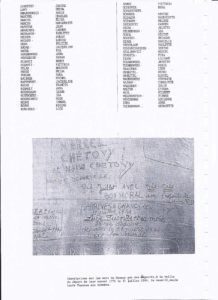

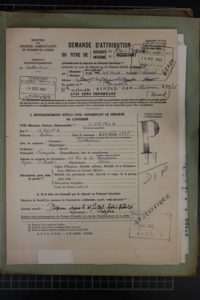
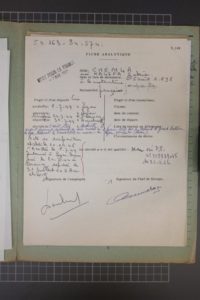
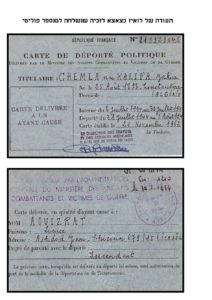
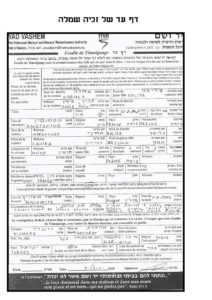
She also continued, through her findings, to restore the identity of each member of her family.
We have tried to pay tribute to Zakia by writing snippets of her biography.
CONCLUSION
We would like to end the biographies of the Chemla family members, who were deported on Convoy 77, with a brief conclusion including some iconographic images produced by one of the students in our class and a video by Mr. Richard Avizrat, one of the family’s descendants.
This shameful and monstrous period of history has also prompted us to remain vigilant in the face of rising intolerance and discrimination.
Writing the Chemla family biographies has been a wake-up call for us, because it serves as a reminder that we all have families and that we could all have come from different backgrounds.
This should help to change attitudes and to encourage sharing, because as the singer Maxime le Forestier said: “[…] You don’t choose your family […] Being born somewhere, for the person being born – it’s always a matter of luck.
This research has made us aware of the duty to remember and our conversation with Mr. Avizrat has shown us that despite the hatred and violence, trees will always continue to blossom.
We wanted to pay tribute to the deported Chemla family with a more paradisiacal image than that portrayed the introduction and to show that thanks to Louise, the family lineage will continue.
Lastly, there is also a video, produced by Mr. Avizrat, to keep the memory of the family alive.
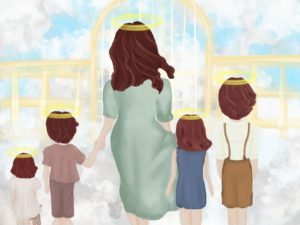
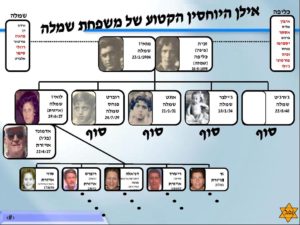
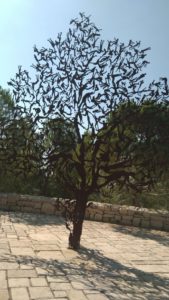
1931– 1944/ الولادة : قسطنطينة / الاعتقال : ليون / الإقامة : قسطنطينة
هوغيت شملة 1931-1944
مقدمة
نود بداية أن نعبر عن شكرنا للسيد ريشار أفيزرات القاطن بإسرائيل على مساعدته القيمة وللوقت الذي خصصه لنا من أجل محاولة إعداد سير أفراد عائلته الذين قتلوا في معسكر أوشفيتز يوم خامس غشت 1944، وهم جدته زكية، وأعمامه وعماته، روبير، هوغيت، جلبير وجورجيت. بعد ذلك سنواصل هذه المقدمة بإجراء حوار مع السيد أفيزرات وأيضا بالتعبير له عن شعورنا خلال هذا اللقاء المؤثر الذي تبادلنا فيه أطراف الحديث.
أما شعورنا، بعد نداء السيد ريشار أفيزرات، حفيد زكية شمْلة، فهو أننا علمنا بأن والدته قد توفيت، بينما هو لم يكن يتكلم عن العائلة ولم يكن يطرح أسئلة، فالسيد أفيزرات كان على علم بما جرى من خلال الدروس المقدمة بالمدارس.
يعيش السيد أفيزرات بإسرائيل، وحينما بلغ سنه الخمسين بدأ أبحاثا في ياد فاشيم (المعهد الدولي لذاكرة المحرقة بإسرائيل)، ثم ذهب مرتين إلى باريس للقاء ابنة عمته، ومرة زار ليون للقيام بأبحاث أخرى. وقد فتش عن الوثائق وعثر على بعض الصور عند والديه.
ساعدته عمادة ليون وشرطة المدينة على القيام بهذه الأبحاث. وهو يتخيل حياة عائلته المرحّلة مثل مربكة (بوزل) ذلك أنه، يوما بعد يوم، كان يعثر على عدد أقل من المعطيات. ومنذ 2006 لم يتوقف أبدا عن البحث عن معلومات جديدة عن عائلته، كما قرأ عدة مؤلفات بغاية توسيع تحرياته.
وأخيرا، نظرا للأزمة الصحية (الناجمة عن الكوفيد) والأرشيفات المتوصل بها من طرف جمعية القافلة 77، بفضل السيد سيرج جاكوبير والسيدة كلير بوديتي اللذين نعبر لهما عن شكرنا، فقد حاولنا، وبأفضل طريقة ممكنة، تكريم هذه العائلة المنتمية للتكتل العمراني الليوني (نسبة إلى مدينة ليون) والتي عاشت بالجزائر، تاركة في حزنها لويز أفيزرات-شملة، المنحدرة من العائلة، والتي واصلت بحثها لمعرفة وضعية والديها وإخوتها وأخواتها المقتولين والمرحّلين (والدها موسى قتل رميا بالرشاش). إنه -جزئيا- بفضل مثابرتها نستطيع اليوم الاحتفاظ بأثر لذاكرة عائلة شملة.
مربكة (بوزل) التاريخ





السيرة



ولدت زكية خليفة في 25 غشت 1898 بقسطنطينة بالجزائر إبان الاستعمار الفرنسي. كانت تعيش مع عائلتها، وزوجها موسى وأبنائها الثلاثة الأوائل : لويز، روبير وهوغيت.
لم تكن زكية تشتغل، بينما كان زوجها يوفر للعائلة حاجاتها المعيشية بالاشتغال كعامل يدوي عند ديسكور-كابو، وهو معمل لمواد البناء موجود منذ 1782 بمدينة ليون.
ولكي تلتحق بجزء من أسرتها ذهبت للاستقرار بفرنسا صحبة زوجها وولديها الأخيرين. لكن نجهل التاريخ الحقيقي لانتقالها. ومع ذلك فلو اعتبرنا أن ولادة جلبير وهوغيت كانت سنة 1931، لأمكننا أن نقدر مجيئهم إلى ليون بعد هذا التاريخ.
فكل ما نعرفه هو أن لويز اضطرت للبقاء في الجزائر لأسباب صحية، غالبا ذات علاقة بالمناخ.
ونعتقد، حسب الوثائق التي في حوزتنا، وخاصة الصور، بأن زكية كانت امرأة متزنة، منحدرة من عائلة كبيرة ومحبة للطبيعة. وبعد وفاة زوجها موسى، الذي قتل رميا بالرصاص يوم 20 أبريل 1944 بسبب أنشطته ضد ألمانيا، فإن غارة الشرطة واعتقالها صحبة أبنائها، من شقة للأصدقاء يوم ثامن يوليوز 1944، كان بداية محنة هذه العائلة، فقط بسبب انتمائها الديني.
ويكشف تنقيل أفراد العائلة يوم 24 يوليوز 1944 إلى معتقل درانسي، معقل العبور بناحية باريس، عن مستوى التنظيم المضبوط والدقيق لعمل التقييد والتنقيب الذي قامت به الشرطة الفرنسية.
والشيء الوحيد ذو القيمة، الذي كان بحوزة زكية، هو قرط أذن، أما بقية القصة فهي معروفة : إذ يوم 31 يوليوز 1944، صعدت مع أبنائها ومرحّلين آخرين ضمن القافلة 77 باتجاه معسكر الموت في أوشفيتز-بيركوناو في بولونيا كي تنتهي بذلك حياتها يوم خامس غشت 1944.
في نهاية الحرب فإن غالبية الناجين (الذين كانوا مختفين أو الذين تم إنقاذهم أو الذين كانوا يعيشون في بلدان أخرى) قد باشروا أبحاثا، أحيانا مع دواليب إدارية صعبة لم يكن من السهل تذليلها، وذلك بقصد العثور على ناجين من عمليات الترحيل.
كانت هذه، في فترة أولى، حالة زكية، وياسمينة مابيتز، ثم حالة ابنتها لويز أفيزرات التي باشرت إجراءات للاعتراف بوالدتها وكذلك إخوتها وأختها بكونهم مرحلين سياسيين مع ذكر صفة “متوفى من أجل فرنسا”.

















وقد ساهمت أيضا من خلال شهادتها في رد الاعتبار لهويات كل واحد من أفراد عائلتها.
فبكتابة هذه الشذرات من سيرتها، نحاول تكريمها.
خاتمة
نود اختتام سير عائلة شملة، المرحّلة عبر القافلة 77، بخاتمة قصيرة مصحوبة ببعض الوثائق الأيقونية والمصورة المنجزة من قبل تلميذة من القسم والسيد ريشار أفيزرات، أحد المنحدرين من العائلة.
ذلك أن هذه المرحلة المخجلة والبشعة تدفعنا لنظل حذرين تجاه تصاعد التعصب والتمييز.
إنجاز هذه البيوغرافيات لعائلة شملة كان بمثابة مٌنبه، ذكّرنا جميعا بأن لكل منا عائلة، وبأنه يمكننا المجيء من آفاق مختلفة. هذا ما ينبغي أن يسمح بتطوير العقليات وتقاسم الذكريات، ومثلما يقول المغني مكسيم لوفوريستي : “لا نختار عائلتنا. فأن تولد في مكان ما بالنسبة للمولود هو دائما صدفة”.
هذا العمل البحثي مكّننا من أن نعي واجب الذاكرة، كما أتاح لنا الحوار مع السيد أفيزرات أن نرى، بأنه رغم الكراهية والعنف، فإن الشجرة ستستمر دوما في الإزهار.
ونود بالمناسبة تكريم عائلة شملة المرحّلة بصورة أكثر جاذبية مما جاء في المقدمة، مع التنويه أنه بفضل بقاء لويز على قيد الحياة فإن الخلف سيظل مضمونا.
وأخيرا ستجدون فيديو أنجزه السيد أفيزرات كي نحتفظ دائما في ذاكرتنا بما جرى.
هذه السيرة أنجزها تلاميذ السنة الأولى بثانوية أميلان كوتيي بالشالون-سور-ساون، تحت إدارة السيدة تيبـر، أستاذة الأدب والتاريخ والجغرافيا.





 Français
Français Polski
Polski









Bonjour,
Je viens de découvrir ce site. Je suis parentee a la famille Chemla . Ce sont mes cousins . Ma mere était la soeur de Moise Chemla. C’est très émouvant de découvrir ces documents sur ma famille disparue. C’est réconfortant de savoir que Louise, la seule survivante, a pu construire une famille en Israel. Merci d’avoir fait ces recherches et d’étudier l’horreur qu’était la Shoah. Le devoir de la memoire est primordial. Il ne faut jamais oublier.